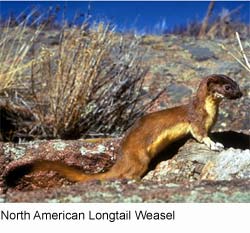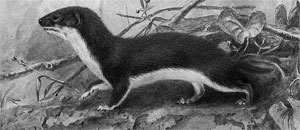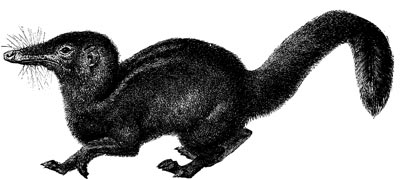|

Sizes and Scales: Weasels vary in length from 15 to 35 centimeters (6 to 14 inches), and usually have a light brown upper coat, white belly and black fur at the tip of the tail; in many species, populations living at high latitudes moult to a white coat with black fur at the tip of the tail in winter.
 Tall Tails: They have long slender bodies, which enable them to follow their prey into burrows. Their tails are typically almost as long as the rest of their bodies. As is typical of small carnivores, weasels have a reputation for cleverness and guile. Tall Tails: They have long slender bodies, which enable them to follow their prey into burrows. Their tails are typically almost as long as the rest of their bodies. As is typical of small carnivores, weasels have a reputation for cleverness and guile.
What's in a Name? The Least weasel (Mustela nivalis) is the smallest member of the weasel genus, Mustela and indeed the smallest living carnivore. In Britain it is known simply as the Weasel, and this is the original use of the word.
In zoological use "weasel" on its own is now more usually applied to the genus, and in North America it is used as a common name for a number of species. However, most literary references to weasels are in fact to the Least Weasel. The sinister Weasels of The Wind in the Willows, for example, are Mustela nivalis, and so is the Weasel that goes "pop" in the nursery rhyme.

Hypnotic Dancer? Most weasels feed on small mammals, and in former times were considered vermin since some species took poultry from farms, or rabbits from commercial warrens. Some species of weasel have been reported to perform a "hypnotic dance" in front of prey, which appears to mesmerize it. In folklore at least, this behavior is particularly associated with the stoat.
Where in the World? The Least weasel is found throughout the northern parts of Europe, Asia and North America, except for Ireland and eastern Canada; it extends as far south as North Africa. It has been introduced into New Zealand. The North American population was formally classified as a separate species, Mustela rixosa, but it is now thought that the distinction cannot be maintained. They are generally found in farmlands, meadows, brushy areas and woodland edges.

Long and Lean: Like all weasels, the Least weasel is a slender animal with a long tail and short legs, enabling it to follow its prey—mostly small rodents—into their burrows. However they can take hares, which can be more than 100 times its own size! Its fur is reddish-ginger, brighter than that of most other weasels, with white belly fur; in the northern parts of its range it moults to pure white in winter, as camouflage against the snow (which is why it goes by the name of Snow weasel in some northern regions, and is called Snow Mouse in Norway and Sweden). It is rarely more than
23 cm in length. Although most active at night, weasels are sometimes seen during the day.
Weasel Wrath: Least weasels are highly solitary, and even mating does not occur without a fight. Females can breed several times in a year when food is plentiful. Perhaps because of their small size, Least weasels have an even greater reputation for ferocity than the other weasels, and there are many references to them in the popular cultures of different countries.

Good Luck Weasel: Traditional Inuit lore held the Least weasel in great respect because of its pugnacious nature, and the capture of one was regarded as an omen of good luck. In classical and medieval European mythology, it is sometimes said that the only thing which can kill a basilisk is a weasel, though it would be killed in the conflict as well. The earliest record of this claim is in Pliny's Naturalis Historia, book 8, par. 33. It was repeated by Isidore of Seville in his Etymologiae, and subsequently by many medieval bestiarists.
Through much of its European range, the Least weasel overlaps with the somewhat larger but otherwise similar Stoat.

Of the 16 extant species currently classified in the genus Mustela, only 10 have "weasel" in their common name. Among those that do not are the stoat, the two species of mink, and the polecats or ferrets.

All text is available under the terms
of the GNU Free Documentation License
|